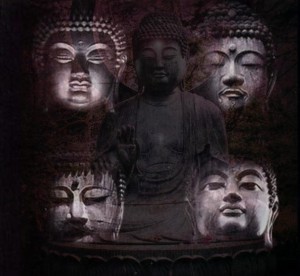Entering Bardo Realm Three, we discover that the Sambhogakayic-field we encountered in Bardo Two also encompasses what is to be revealed in this present Bardo of Meditation and Deep Samadhis, although the emphasis now is on the Pure Sambhogakayic Continuum—the Enjoyment (Transcendent) Realm wherein Buddhas, Bodhisattvas and other advanced Spiritual Beings truly enjoy pure bliss on the ten planes of Perfected Spiritual Perfection. Amongst this most auspicious Sambhogakayic body reside “The Five Tathagatas”, or the Five Buddhas. They are also known as the Meditation-Buddhas. These Five-Tathagatas are emanations from the Primordial-Buddha Samantabhadra—or the Absolute Shining Dharmakaya. They represent basic rudiments of Holy Wisdom, that for our preliminary purposes in this Bardo-Realm are to counteract and neutralize the influence of the corresponding Five Skandhas. They also comprise the great Mandala of Transformation that is part and parcel of this Sambhogakayic Continuum. At this junction, a general breakdown, a snapshot if you will, of their significance is as follows:
THE BUDDHA VAIROCANA
Perhaps the most radiant of the five since this Buddha is the Total Revealed Wisdom-Truth of the Dharmadhatu. He essentially overcomes the poison of ignorance (avidya) and illusion and is associated with the corresponding Skandha of Form; his all-pervasive Wisdom Plane transmutes this Skandha into the Absolute Buddha Body—Buddhakaya. He resides in the Center of the Transformation-Mandala; his color is White—symbolizing Pure Unadulterated Consciousness. His centralized-Tathagatahood position within the Transformation-Mandala also signifies his family=Buddha. Vairocana’s Symbol is the Dharmachakra—or the Turning Eight-Spoked Wheel of the Buddhadharma; his mudra is the gesture of teaching, or Dharmachakra Mudra. The Mantra associated with Buddha Vairocana is Om Vairochana Om.
THE BUDDHA AKSHOBHYA
The name means the “Immovable” or “Unshakable” One. He is forever known as having a Mirrorlike Wisdom that can transmute the darkest of images into the Clear Light of the Dharmakaya Itself. He essentially overcomes the poisons of hatred and anger and is associated with the corresponding Skandha of Consciousness (vijnana); indeed, his mirror-like Wisdom transmutes any volatile and misshapen imagery of the Alaya-receptacle into Translucent Unborn Light. He resides in the Eastern quadrant of the Transformation-Mandala; his color is blue, reflective of the Luminosity of the Dharmakaya Itself. Akshobhya is the Ruler of the Vajra Family and his corresponding symbol is that of the Vajra itself—signifying its indestructible diamond-like resiliency in the face of all evils. His mudra is the Bhumisparsa Mudra, or the earth-touching gesture that bespeaks the resilient groundedness of the Amala Consciousness. The Mantra associated with Buddha Akshobhya is Om Akshobhya Hūm.
THE BUDDHA RATNASAMBHAVA
Ratnasambhava’s name means “the jewel-born, wish-fulfilling one” or the Source of all precious-things. Ratnasambhava is especially known for transmuting the poison of all forms (spiritual, intellectual, and material) of hatred into the Absolute Wisdom of equality and equanimity; in this sense his corresponding Skandha is that of feeling or sensation—wherein the rabidness of hatred can be transmuted and quelled into a semblance of quietude and Absolute Peacefulness. He resides in the Southern Hemisphere of the Transformational-Mandala and his symbol of course is the radiant jewel; his color is that of a Golden-Yellow, signifying the shining sun of Absolute Satisfaction in the Sugata-garbha, or the Supreme Womb of Buddhaic Light. Ratnasambhava is the ruler of the Ratna Family and his corresponding symbol is the Chintamani—or the Shining Jewel manifesting the Liberated Mind. His mudra is the Varada Mudra, or the palm-opening gesture that reflects an open and Self-giving display of equanimous compassion. The Mantra associated with Buddha Ratnasambhava is Om Ratnasambhava Tram.
THE BUDDHA AMITABHA
Amitabha is known as the Buddha of Infinite Light. His Discriminating Wisdom is said to overcome and transmute the poisons that accompanies all forms of passions and inordinate desires; his corresponding Skandha is Perception (all cognitive associations that result in “conceptualizations” about perceived phenomena). His wisdom hence pierces through all phenomena and renders it null and void in the Clear Light of the Dharmakaya. He resides in the Western-half of the Transformation Mandala, a location that bears special significance as the “Western Paradise” for followers of Amidism. His color is a beautiful rose—reflective of a magnificent setting-sun. Amitabha is the ruler of the Padma family—or the wondrous unfolding Lotus, which is his symbol. His mudra is the classic Dhyana Mudra, or the palms-up, right hand on top of left meditation pose. The Mantra associated with Buddha Amitabha is Om Amitabha Hrih—although there are numerous variables associated with Amida followers, such as Namu Amida Butsu.
THE BUDDHA AMOGHASIDDHI
The name bespeaks the “Almighty Conqueror” and also the Lord of Karma. His is an All-Accomplishing Wisdom that transmutes the poisons of envy and jealousy into the perseverance of the Recollective Resolve. His corresponding Skandha is Volition, or Motion—signifying that Karmic “Action”. Amosghasiddhi bears salient significance in the bardo of the later stages as future-karma becomes solidified and determines the wayfarer’s next incarnation. His color is a radiant Turquoise Green. He resides in the Northern Hemisphere of the Transformation Mandala—which takes on special significance as the departing awareness principle exits the head via the crown, or Dharmamegha Chakra at death. His Symbol is the Dorje, or Double (thunderbolt) Vajra. His mudra is the Abhaya Mudra, or the raised gesture of Fearless-Protection. The Mantra associated with Buddha Amoghasiddhi is Om Amoghasiddhi āh hūm.

